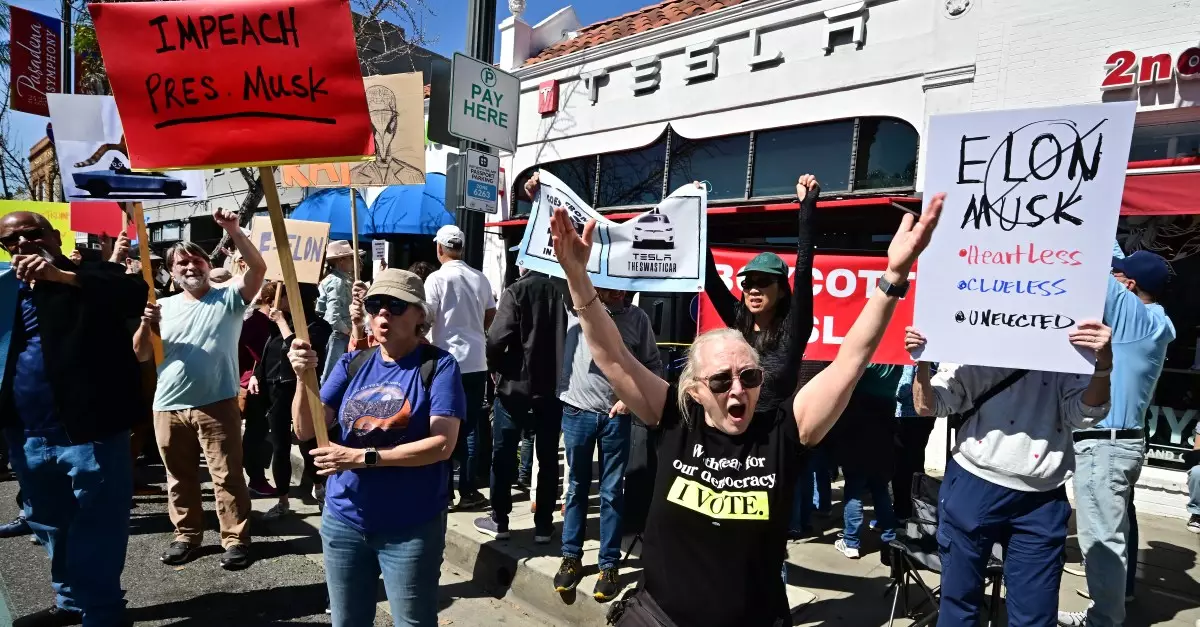On March 29, a collective of demonstrators is set to ignite a wave of dissent, planning what they describe as the “biggest day of action” ever directed at Tesla. With aspirations to conduct 500 demonstrations across all 277 Tesla showrooms and Supercharger stations globally, this initiative is more than just a set of protests; it’s a direct challenge to corporate power and the controversial leadership of Elon Musk. The organizers, fueling this uprising, are adamant: they will not stand silent while what they perceive as attacks on democracy and federal government support proliferate under Musk’s administration.
Since early February, the movement has seen significant growth, morphing from a handful of protests into a formidable worldwide coalition of citizens eager for change. People are rallying not just to express their dissatisfaction but to instigate a rethink of Tesla’s operational ethics and leadership ethos. The protests focus on Musk’s decisions to eliminate federal assistance programs, actions that have led to significant layoffs within governmental ranks, sending ripples of concern through the country. The notion of harming the environment of dissent around Tesla—a beacon of innovation for many—raises questions about the moral compass of its leadership.
Defensive Stance Against Accusations of Violence
The movement strives to distinguish its peaceful objectives from the violence that has recently marred some Tesla locations. With incidents escalating into vandalism and arson, the sentiments surrounding the protests have thickened, inviting scrutiny and disdain from figures like President Trump and Musk himself, who have branded these actions as “domestic terrorism.” In the wake of such characterizations, the coalition organizing the protests has taken on a defensive posture, emphasizing nonviolence and peaceful assembly in their calls to action.
Prominent figures from varying backgrounds, including academics, journalists, and cultural icons, have lent their voices to the cause, reinforcing the resolve to champion democracy and freedom. Representative Jasmine Crockett’s statements epitomize this sentiment: fighting for freedoms shouldn’t resort to physical confrontation, demonstrating how protest movements aim to uplift their ideals rather than disrupt them through violence. This advocacy strategy is pivotal amid rising tensions, as legal threats loom over demonstrators advocating for justice and accountability.
A Deep Dive into Tesla’s Declining Stock
Another driving force behind the uprisings is Tesla’s faltering stock value, which has dropped nearly 40% since the year’s start. This decline is not just a financial statistic; it symbolizes a broader erosion of confidence in Musk’s leadership and the sustainability of a business model positioned at the confluence of innovation and commercial aspiration. Key voices, including investigative journalist Micah Lee, interpret this volatility as an opportunity for activists to capitalize on weakening public perception of the brand, arguing that targeting Tesla’s market value could force structural changes within the company.
Lee’s assertion poses a strategic angle on the protests, suggesting that if the movement succeeds in damaging Tesla’s financial health, it may also destabilize Musk’s vast political and economic influence. This point raises vital questions about accountability at high levels of corporate governance and whether institutional safeguards can truly function when wealthy individuals hold disproportionate sway.
Political Factions and the Role of Technology
Musk’s positioning as the world’s richest individual, largely due to Tesla’s market performance, is a vivid illustration of how economic power intertwines with political influence. His control over Tesla is not just about overseeing automobile production; it demonstrates a larger narrative where corporate executives effectively engage in governance. This duality complicates the protests further, as it illustrates that for Musk—even as stock prices falter—the broader political machinations he engages in may shield him from consequences that would typically befall leaders in other sectors.
Adding to the complexity of this situation is Musk’s astute maneuvering within the technology realm. His penchant for memes and social media engagement showcases a more whimsical side, which distracts from the seriousness of the critiques leveled against him. Academics like Joan Donovan argue that this perceived detachment from reality allows Musk to manipulate narratives to his favor, creating a façade that may render traditional means of activism less effective. This underscores the difficulty protesters face—not merely battling an industry titan but confronting the cognitive dissonance he fosters through his public persona.
Facing an Urgent Reality
As the date for the demonstrations approaches, the urgency of addressing these issues becomes increasingly apparent. The mobilization reflects widespread frustrations—such as fears of authoritarianism, diminishing democratic freedoms, and corporate overreach. It symbolizes a potent call to resist a leadership that many feel has strayed far from the original promises of innovation and ethical alignment that Tesla once represented. Therefore, as protesters gather to demand accountability, they are not just seeking to challenge a company; they are positioning themselves in a larger struggle for the future of democratic rights in an age where corporate interests frequently overshadow public welfare. The stakes could scarcely be higher.

